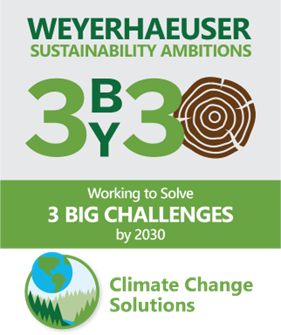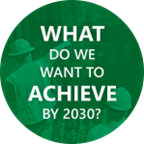 Climate
Climate
Our working forests contribute to climate change solutions
WHAT IS THE CHALLENGE?
Climate change threatens to affect everything from how we do business to the well-being of our team and communities to the health of ecosystems around the planet. As global temperatures climb, changes in surface temperature and precipitation trends are leading to increased frequency and intensity of extreme weather events, wildfires and a loss of biodiversity. Sea-level rise, rising ocean temperatures and changes to standard growing conditions present challenges to our coastal communities and forests around the world. Risks to society, including threats to food security, water supply and economic growth, are also increasingly likely and severe.
To avoid the worst projected impacts, the Intergovernmental Panel on Climate Change has stressed the need to limit global warming to no more than 1.5 degrees Celsius. All pathways to limit warming rely on rapid and dramatic reductions in greenhouse gas emissions, coupled with the transition to low- or zero-carbon energy sources and materials and the removal of CO2 from the atmosphere to counterbalance residual emissions.

WHAT IS OUR ROLE?
As the steward of millions of acres of sustainably managed forests in the United States and Canada, and one of the largest producers of wood products in the world, we are uniquely positioned to be part of the solution to the global challenge of climate change — and to help address the risks this crisis poses to our people, our operations and the communities where we live and work.
Our role in addressing climate change is multifaceted, starting with reducing our CO2 emissions and producing low-carbon energy sources and materials. But our most significant contribution comes through providing immediate and long-term solutions to remove CO2 from the atmosphere. All the trees in our millions of acres of forests naturally sequester CO2 as they grow and store it as solid carbon. Every wood product we produce, or that our customers make from our logs, stores much of that carbon for the life of the homes and buildings those finished products are used to build. After harvest, we replant new trees (or in some situations, we make sure the forest is regenerated naturally) to begin the cycle again. Every year, our growing landscape of trees removes more carbon than is released through harvesting. It’s part of a continuous and ever-increasing equation of carbon sequestration and storage on the landscape and in our products, and it makes working forests powerful, far-reaching and cost-effective tools for limiting the concentration of CO2 in the atmosphere.
As one of the world’s largest private forest landowners, we recognize our responsibility to manage our forests well in the face of climate change, and we work to ensure they stay healthy and productive and continue to act as a natural climate solution. We also know that climate change is projected to more severely affect communities that are already vulnerable, and we are committed to leveraging our sustainable working forests and our influence as a company to deliver equitable, climate-smart solutions that benefit everyone.
WHAT DO WE WANT TO ACHIEVE BY 2030?
By 2030, we envision a world where the value of working forests and the products that come from them are fully recognized as one of the key solutions for slowing and reducing the impacts of climate change. Through our research, stewardship and industry leadership, we endeavor to be a model for how working forests can and should be part of a sustainable, biodiverse and climate-resilient solution — today and long into the future.
WHERE ARE WE FOCUSED FOR PHASE 2?
While there is much we can accomplish over a decade, we have structured our long-term goals into three-year phases to effectively prioritize and accelerate progress. Currently, we are two-thirds of the way through the second phase of our 3 by 30 Climate Sustainability Ambition — running from 2023 to 2025 — and are focusing our work in two key areas:
Improving the understanding of working forests and wood products as a climate solution
For working forests and wood products to effectively contribute to climate change mitigation, we need broader public awareness and understanding of their unique benefits as a mechanism for carbon sequestration, carbon storage and climate resilience.
We have three key objectives within this focus area:
1. Prove that working forests and wood products are critical to fulfilling net-zero targets
Actions include: annual progress toward achieving greenhouse gas reduction targets; continued engagement with the development of GHG protocol standards; and collaborating with The Nature Conservancy to further the scientific understanding of how forests and forest products contribute to climate mitigation.
2. Provide natural climate solutions
Actions include: growing our Natural Climate Solutions business through high-quality forest carbon projects, leasing subsurface ownership for carbon capture and sequestration, renewable energy development and mitigation banking, among other activities.
3. Position working forests and wood products as contributors to climate solutions
Actions include: representing the forest sector in global climate coalitions and advocating to incorporate working forests and wood products into policy and law as climate solutions.
Demonstrating that working forests are climate resilient
Forests are complex ecosystems, and the potential impacts of climate change on forest health and productivity are constantly evolving. Understanding and incorporating climate-related risks and opportunities into our business decisions will be vital to ensuring our working forests remain a climate solution — and model that success — for generations to come.
Actions include: ensuring the trees we grow are adapted to a changing climate; developing climate-smart decision tools; preparing our forest infrastructure for climate-related events; and deploying climate-informed disaster response plans.
PHASE 2 ACCOMPLISHMENTS
During the second phase of our 3 by 30 Ambitions, we are intentionally making fewer, but more strategic, investments of our time and resources. While much of our Phase 2 work is ongoing, we have already achieved several important milestones.
- We monetized our first forest carbon project in Maine, registered a project in Mississippi and laid out our Carbon Credit Principles describing the foundational beliefs and approaches that guide our participation in the carbon market.
- We published our GHG Inventory Principles to demonstrate our leadership in carbon integrity and to advocate for our preferred approach to forest carbon accounting, which draws on years spent building our own GHG inventory, implementing best practices and incorporating input from nonprofits and scientific advisors.
- We developed climate-focused partnerships with leading environmental nonprofits, including a multiyear collaboration with The Nature Conservancy focused on advancing natural climate solutions science, carbon methodologies and climate-smart forestry.
- We supported academic research into climate-resilient forestry by partnering with North Carolina State University to study the impacts of climate change and sea-level rise on coastal forests, and with the University of Georgia’s Southern Pine Health Research Cooperative to explore real-time monitoring of insects using automated sensors.
- We catalyzed the development of a new forest and wood carbon data platform from the U.S. Forest Service and U.S. Endowment for Communities and Forestry to help the entire sector tell a more credible and coherent story about the carbon impact of forests and wood products.
- We developed our Scope 1 and 2 net-zero transition plan and refreshed our Scope 3 GHG emissions inventory and continued to make progress toward our 2030 emission-reduction targets.
To ensure transparency and accountability, we will continue sharing our accomplishments and baseline measures from Phase 2 semi-annually.
FOUNDATIONAL SUCCESSES FROM PHASE 1 (2020 – 2022)
In the first phase of our work to achieve our 3 by 30 Sustainability Ambitions, we laid the groundwork for meaningful progress toward our goals. We accomplished over 90 percent of the action items we set out to achieve with remaining actions rolled into Phase 2.
KEY ACCOMPLISHMENTS
We drove alignment within the forest sector by calculating and disclosing the net change in carbon stored in our forests and sourcing regions and the carbon in our wood products, demonstrating that our company removes significantly more carbon than we emit through our operations.
We expanded our greenhouse gas inventory to include Scope 3 (value chain) emissions.
We completed the first external assurance of our Scope 1 and 2 GHG emissions inventory and data.
We set an ambitious short-term greenhouse gas reduction target that was approved by the Science-Based Targets initiative as in line with limiting warming to 1.5C. Our target includes a commitment to reduce Scope 1 and 2 GHG emissions by 42 percent by 2030, measured against a 2020 baseline.
We joined The Climate Pledge and committed to achieving net-zero emissions by 2040 — 10 years ahead of the goals of the Paris Agreement. This commitment means we intend to measure and report greenhouse gas emissions on a regular basis; implement decarbonization strategies in line with the Paris Agreement through real business changes and innovations; and neutralize any remaining emissions with additional quantifiable, real, permanent and socially beneficial offsets (or removals) to achieve net-zero annual carbon emissions by 2040.
We secured a key seat at the table in the technical working group responsible for drafting the GHG Protocol on Land Sector and Removals Guidance. We piloted the guidance and continue to work closely with other sector leaders to identify opportunities to improve the guidance and confirm the role of forest-based solutions.
We participated in the World Business Council for Sustainable Development’s Forest Sector Net-Zero Roadmap, which received global recognition at COP26.
We helped launch the Forest to Frame Carbon Alliance, a sector-wide initiative to build transparency and credibility in forests and wood products.
We identified climate-related risks and opportunities and prepared our first, now annual, Taskforce for Climate-Related Financial-aligned disclosure.
Our Natural Climate Solutions business emerged as a clear example of strong alignment with our overall business strategy. We enabled the development of renewable energy projects on our land base, laid the groundwork for our first forest carbon project, and worked to maintain and build the credibility of the voluntary carbon market as a key part of achieving net-zero standards and climate goals.
Our Timberlands Strategy and Technology team developed a comprehensive Climate Science Prospectus and began integrating key activities to prepare for current and future climate-related business disruptors.
We participated in the process to update Sustainable Forestry Initiative® standards, which added climate considerations to the Forest Management standard, to ensure the new standard is responding to the increasing threat posed by climate change.
By using this website, you agree to our Privacy Policy. California residents: See our CCPA Privacy Notice for details on what personal information we collect and for what purposes.



